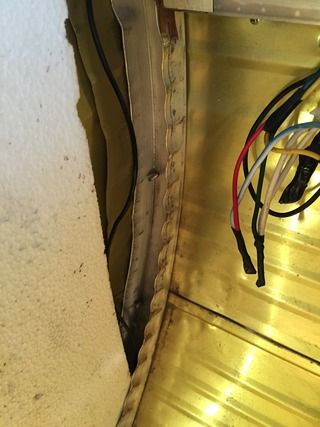|
|
Post by Mustang on Aug 2, 2015 19:21:03 GMT 10
Thanks SO much Kharde that is awesome. Thelowest area is what i will replace the straight then curved beam from wheel arch to just below where you show cross member.So down the track if anything leaks it will not be an issue for those who hate timber frames. All the other timber is top rate so i have sanded & varnished what i have exposed so far. Nothing like a good size classic to get folks talking, now they are used to seeing the tear drops & bondwoods around. Anything out of the white box ordinary should get due credit. HiAte, Is this the corner aluminium(joint?) you wanted an image of? Rippled & attatched to the aluminium frame top & bottom, it seems very strong with the cladding attatched.  While the ply wood was all rotted out in our van, there was no deteriotion in the frame, or the chassis, or the cladding, or the floor??? Why was their waterproofing so ordinary, did the water come in around the windows,? this is where the water must have penetrated?? Not meaning to hi-jack your thread " The Man Van - 18" Viscount 1974 " |
|
|
|
Post by atefooterz on Aug 2, 2015 19:27:59 GMT 10
Thanks SO much Kharde that is awesome. Thelowest area is what i will replace the straight then curved beam from wheel arch to just below where you show cross member.So down the track if anything leaks it will not be an issue for those who hate timber frames. All the other timber is top rate so i have sanded & varnished what i have exposed so far. Nothing like a good size classic to get folks talking, now they are used to seeing the tear drops & bondwoods around. Anything out of the white box ordinary should get due credit. HiAte, Is this the corner aluminium(joint?) you wanted an image of? Rippled & attatched to the aluminium frame top & bottom, it seems very strong with the cladding attatched.  While the ply wood was all rotted out in our van, there was no deteriotion in the frame, or the chassis, or the cladding, or the floor??? Why was their waterproofing so ordinary, did the water come in around the windows,? this is where the water must have penetrated?? Not meaning to hi-jack your thread " The Man Van - 18" Viscount 1974 " Ahh interesting pleated L section on the inner face. cheers Mustang, saving me from overbuilding that area.  |
|
|
|
Post by kharde on Aug 2, 2015 22:08:24 GMT 10
That's the framing corner piece I was trying to explain. Pleated is a much better term... and Yes - the framing around all curves seems stronger than the normal framing. Very strong stuff.
As mentioned, I sat in the stripped back van during a thunderstorm and watched the water entry points were (in order of worst first):
i) Tail brake light region (the light in the centre). I needed to silicone the top of the metal casing that the number plate was attached to. The water was FLOODING in during the storm
ii) Roof Vents.. Likewise, the water flooding through both roof vents.
iii) External aluminium moulding. Had to take off all corner pieces, polish the mastic back and silicone it all back in place.
iv) Some of the external cladding was cut too small when building the caravan in the first place (did not overlap as needed). I needed to silicone the crap out of the overlap area/s.
v) Surprisingly the rear window never leaked... the front window however only had half a window pane left the frame (so obviously it did not keep the water out).
FYI: I never resealed any of the window frames. None of the window frames leaked during the storm and I could see very minimal trace of water tracks down the insides of the aluminium cladding anyway. Even if the window frames did leak, I could see the water would just run down the aluminium frame and out of the van ... (gotta love the aluminium frame)
|
|
|
|
Post by doublechevron on Aug 4, 2015 11:01:04 GMT 10
They probably used a shrinker/stretcher to create those curves. You would need to be careful with aluminium. I would have thought it would work harden almost immediatly! That's why the curved bits would be so strong ( and likely brittle ). www.youtube.com/watch?v=GmmFjpB55TQseeya, Shane L. PS: Those 2cv guys are crazy. You have no idea. Google "2cv raid" .... they take those little suckers places that would make a modified land cruiser gulp hard. |
|
|
|
Post by atefooterz on Aug 4, 2015 15:20:32 GMT 10
They probably used a shrinker/stretcher to create those curves. You would need to be careful with aluminium. I would have thought it would work harden almost immediatly! That's why the curved bits would be so strong ( and likely brittle ). www.youtube.com/watch?v=GmmFjpB55TQseeya, Shane L. PS: Those 2cv guys are crazy. You have no idea. Google "2cv raid" .... they take those little suckers places that would make a modified land cruiser gulp hard. 2cv with a 20ft dual axle classic, now that would be crazy!  Where most go wrong with bending aluminium is to do it cold or just heat bend and forget, you have to post temper it to have a real chance for long term success. |
|